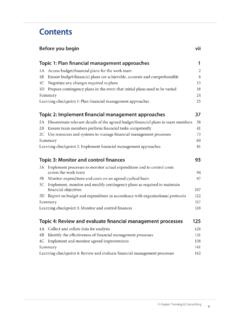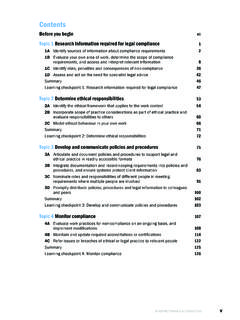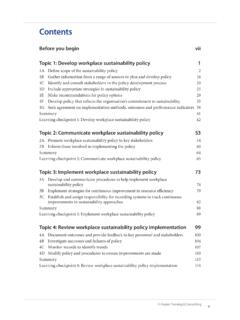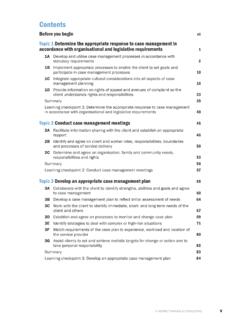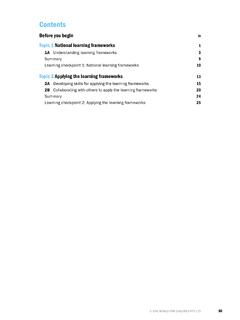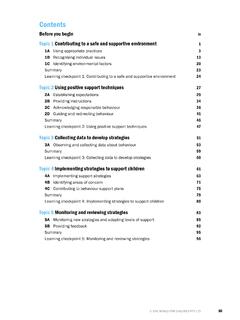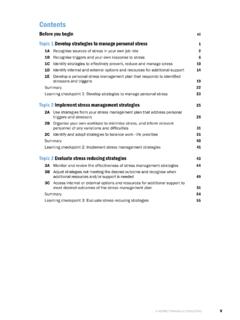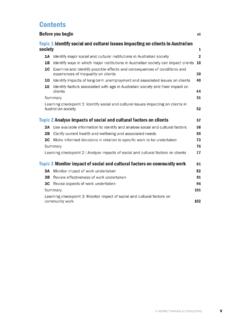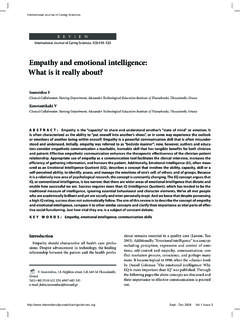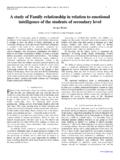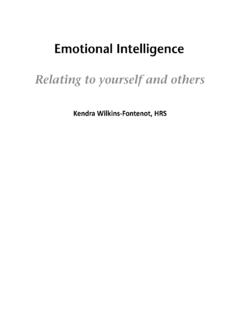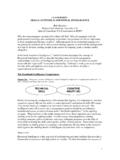Transcription of BSBLDR501 Develop and use emotional intelligence
1 Contents Before you begin vii Topic 1: Identify the impact of own emotions on others in the workplace 1. 1A Identify your own emotional strengths and weaknesses 2. 1B Identify personal stressors and own emotional states related to the workplace 6. 1C Develop awareness of own emotional triggers and use this awareness to control emotional responses 13. 1D Model workplace behaviours that demonstrate management of emotions 17. 1E Use self-reflection and feedback from others to improve development of own emotional intelligence 27.
2 Summary 31. Learning checkpoint 1: Identify the impact of own emotions on others in the workplace 32. Topic 2: Recognise and appreciate the emotional strengths and weaknesses of others 35. 2A Respond to the emotional states of co-workers and assess emotional cues 36. 2B Identify the range of cultural expressions of emotions and respond appropriately 43. 2C Demonstrate flexibility and adaptability in dealing with others 51. 2D Take into account the emotions of others when making decisions 58. Summary 62. Learning checkpoint 2: Recognise and appreciate the emotional strengths and weaknesses of others 63.
3 Topic 3: Promote the development of emotional intelligence in others 65. 3A Provide opportunities for others to express their thoughts and feelings 66. 3B Assist others to understand the effects of their behaviour and emotions on others in the workplace 73. 3C Encourage the self-management of emotions in others 80. 3D Encourage others to Develop their own emotional intelligence to build productive relationships and maximise workplace outcomes 83. Summary 86. Learning checkpoint 3: Promote the development of emotional intelligence in others 87.
4 Aspire Training & Consulting v BSBLDR501 . Develop and use emotional intelligence 1B Identify personal stressors and own emotional states related to the workplace As a manager, it is essential that you identify your personal stressors and emotional states related to the workplace to ensure you care for your own emotional and physical wellbeing and that of your work colleagues. Prolonged emotional stress in the workplace can lead to a loss of commitment to the organisation. As energy, commitment and motivation decrease, unhappy workers may intentionally or unintentionally withhold resources, skills or knowledge from the organisation.
5 Uncertainty and fear related to the economy, or issues relating to your organisation, can make team members feel vulnerable or at risk of personal hardship. Learning and adopting new ways of coping with workplace stress are vital to improving the performance of your team. Workplace stress and stressors Workplace stress refers to the adverse reactions or responses that occur when the demands of a job do not match the resources, needs or abilities of the employee. While some level of stress is expected in the workplace, unnecessary or excessive stress has the potential to hinder a person's productivity or ability to perform in their role.
6 Stressors are events or situations occurring in the workplace that trigger the stress response in an individual or team. Workplace stressors can cause physical, chemical or mental responses inside the body, affecting mental function and performance. As a manager, it is your duty to identify and alleviate any potential workplace stressors that could be detrimental to your health or job performance or to the effectiveness of your team. Here are some stressors commonly found in the workplace. Common workplace stressors Lack of time 1.
7 A lack of time management skills or insufficient work schedules set to complete tasks Too many projects 2. Overcommitting or scheduling projects back-to-back without making concessions for delays or issues that may arise or hinder progress Lack of clarity 3. Ambiguous job roles or excessive work responsibilities and duties Aspire Training & Consulting 6. BSBLDR501 . Develop and use emotional intelligence Physical signs For example, anxiety, insomnia, fatigue, depression, high blood pressure, skin conditions, weight gain, muscle tension, nausea, stomach ulcers, irritable bowel syndrome, increased susceptibility to infections or viruses.
8 emotional signs For example, negative thoughts, disappointment in self, heightened emotional reactions, increased sensitivity, loneliness, loss of motivation, lack of self-confidence, mood swings. Mental signs For example, confusion, lack of concentration, poor memory, indecision. Behavioural signs For example, changes in diet, increased smoking or drinking of alcohol, consumption of stress-related medication, nervous behaviour, arriving late to work, taking more time off. Aspire Training & Consulting 8. BSBLDR501 .
9 Develop and use emotional intelligence Reduce team workplace stress by: offering rewards and incentives showing team members that they are valued providing opportunities for career development establishing a zero-tolerance policy for harassment and discrimination clearly defining job roles and responsibilities sharing information with work colleagues to reduce uncertainty clearly communicating organisational policies and procedures praising good work performance, both verbally and officially including employee contributions in decision-making communicating in a friendly and positive manner consulting team members about scheduling and work tasks providing opportunities for social interaction supporting team members through coaching, mentoring or training.
10 emotional states emotional states are characterised by an unperceived co-occurrence of two or more different emotional feelings, eliciting an instant physiological response to a situation. In other words, your emotional state brings a certain set of feelings that come about with a particular activity or under certain circumstances. For example, if a work colleague accuses you of saying something you didn't actually say, it is likely that you will feel angry as a consequence yet not immediately perceive your own angry state.
